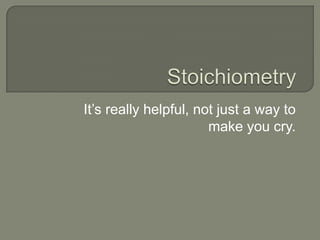
Stoichiometry part 2
- 1. It’s really helpful, not just a way to make you cry.
- 2. What do the 4, 3 and the 2 as coefficients mean ??? A) They are MOLE ratios. B) They are GRAM ratios C) They are atom, molecule and FU ratios. D) They are liter ratios. E) All of the above. F) Only A and C G) Only A, C, and D The coefficients of a balanced chemical equation are MOLE ratios, atom-molecule-FU ratios, or Liter ratios. CHOICE G!
- 3. If you have 40 atoms of Fe and 90 molecules of O2 …. 20 Then you can make _______________ FU’s of the product. iron What is the limiting reactant? _______________ 60 How much of the reactant in excess is LEFT OVER? ______
- 4. If you have 12 atoms of Fe and 6 molecules of oxygen then you can make _______________ FU’s of ferric oxide.
- 5. If you have 400 atoms of Fe and 300 molecules of oxygen then you can make _______________ FU’s of ferric oxide. Weird problem – BOTH are the limiting reactant and you run out of both of them simultaneously !!
- 6. If you have 9 moles of Fe and 6 moles of oxygen then you can make _____________ MOLES of ferric oxide.
- 7. If you have 405 moles of Fe and 300 moles of oxygen then you can make _______________ moles of ferric oxide.
- 8. If you have 4 moles of EACH reactant. HOW MANY MOLES OF THE REACTANT INXS WILL BE LEFT OVER?
- 9. If you have 12 moles of Fe and 15 moles of oxygen how much OXYGEN will be left over after the reaction is complete? __________ And, how much product can you make?__________
- 10. Get your calculator ready. SHOW WORK If you have 100 grams of iron and 100 grams of oxygen how much product can you make? 100 g OX x 1 mole OX x 2 mole product x 160g product 1 32 grams OX 3 mole OX 1 mole product 100 g Fe x 1 mole Fe x 2 mole product x 160g product 1 56 grams Fe 4 mole OX 1 mole product That emphasis means 142 is the answer !!!!!!!!!!!!!!!!!!!!!!!!!!!!!!!!!!!!!!!!!!
- 11. Now we know, from the last slide that if you have 100 grams of each reactant only 142 grams of product are made. Since iron was the limiting reactant, how much of our 100 grams of oxygen is USED UP? ______________ How much of the oxygen is LEFT OVER? _______________
